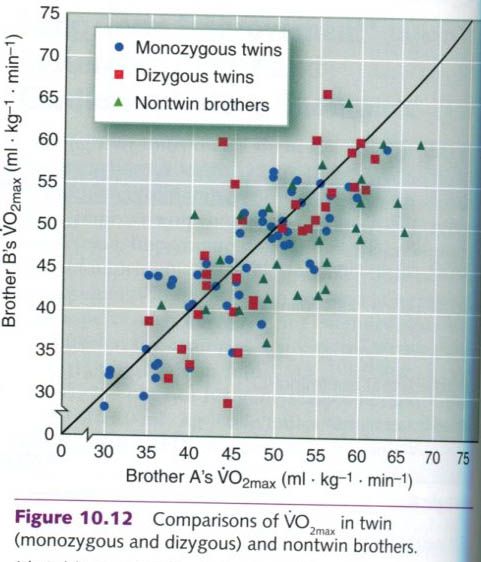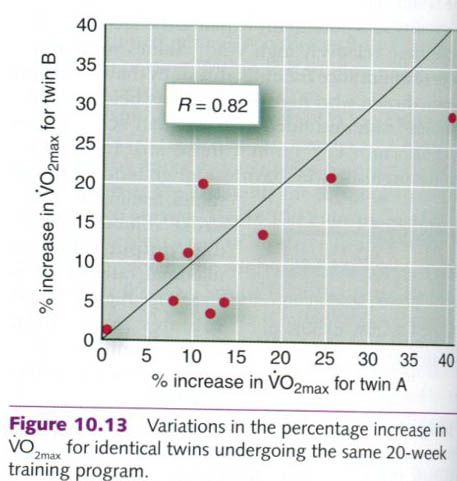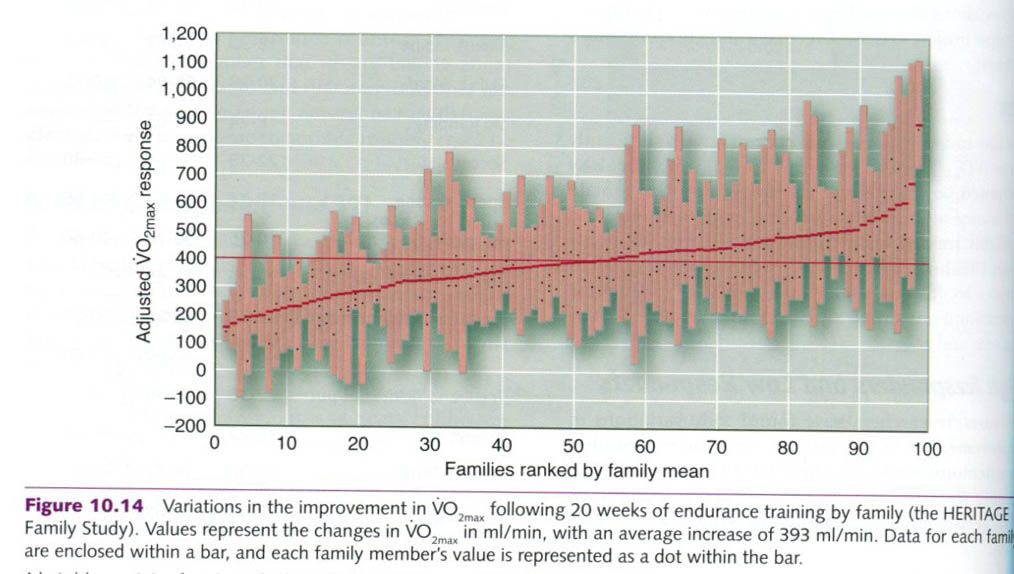A number of years ago, exercise scientists were
divided on what major physiological factor or factors actually limit VO2max.
Two contrasting theories had been proposed.
One theory held that endurance performance was
limited by the lack of sufficient concentrations of oxidative enzymes in the mitochondria. Endurance training programs
substantially increase these oxidative enzymes, allowing active tissue to use
more of the available oxygen, resulting in a higher VO2max. In addition,
endurance training increases both the size and number of muscle mitochondria.
Thus, this theory argued, the main limitation of maximal oxygen consumption is
the inability of the existing mitochondria to use the available oxygen beyond a
certain rate. This theory was referred to as the utilization theory.
The second theory proposed that central and
peripheral circulatory factors limit endurance capacity. These circulatory
factors would preclude delivery of sufficient amounts of oxygen to the active
tissues. According to this theory, improvement in VO2max following
endurance training results from increased blood volume, increased cardiac
output(via stroke volume), and a better perfusion of active muscle with blood.
Evidence strongly supports the latter theory.
In one study, subjects breathed a mixture of carbon monoxide(which irreversibly
binds to hemoglobin, limiting hemoglobin’s oxygen-carrying capacity) and air
during exercise to exhaustion. VO2max decreased in direct proportion
to the percentage of carbon monoxide breathed. The carbon monoxide molecules
bonded to approximately 15% of the total hemoglobin; this percentage agreed
with the percentage reduction in VO2max. In another study,
approximately 15% to 20% of each subject’s total blood volume was removed. VO2max
decreased by approximately the same relative amount. Reinfusion of the
subjects’ packed red blood cells approximately four weeks later increased VO2max
well above baseline or control conditions. In both studies, the reduction in
the oxygen-carrying capacity of the blood – via either blocking hemoglobin or
removing whole blood – resulted in the delivery of less oxygen to the active
tissues and a corresponding reduction in VO2max. Similarly, studies
have shown that breathing oxygen-enriched mixtures, in which the partial
pressure of oxygen in the inspired air is substantially increased, increases
endurance capacity.
These and subsequent studies indicate that the
available oxygen supply is the major limiter of endurance performance. Saltin
and Rowell reviewed this topic and concluded that oxygen transport to the
working muscles, not the available mitochondria and oxidative enzymes, limits
VO2max. They argued that increases in VO2max with training are largely
attributable to increased maximal blood flow and increased muscle capillary
density in the active tissues. The major skeletal muscle adaptations(including
increased mitochondrial content and respiratory capacity of the muscle fibers) appear more closely
related to the ability to perform prolonged, high-intensity, submaximal
exercise.
Table below summarizes the expected
physiological changes that occur with endurance training. The changes pre- to
posttraining in a previously inactive man are compared with values for a world-class
male endurance runner.
Expected
effects of endurance training in a previously inactive man along with values
for a male world-class endurance athlete
|
|||
Sedentary
male subject
|
|||
Variables
|
Pretraining
|
Posttraining
|
World
Class runner
|
75
|
65
|
45
|
|
185
|
183
|
174
|
|
60
|
70
|
100
|
|
120
|
140
|
200
|
|
4.5
|
4.5
|
4.5
|
|
22.2
|
25.6
|
34.8
|
|
Heart volume(ml)
|
750
|
820
|
1.200
|
Blood volume(L)
|
4.7
|
5.1
|
6.0
|
135
|
130
|
120
|
|
200
|
210
|
220
|
|
78
|
76
|
65
|
|
82
|
80
|
65
|
|
Respiratory
|
|||
7
|
6
|
6
|
|
110
|
135
|
195
|
|
0.5
|
0.5
|
0.5
|
|
2.75
|
3.0
|
3.9
|
|
5.8
|
6.0
|
6.2
|
|
1.4
|
1.2
|
1.2
|
|
Metabolic
|
|||
6.0
|
6.0
|
6.0
|
|
14.5
|
15.0
|
16.0
|
|
3.5
|
3.5
|
3.5
|
|
40.7
|
49.9
|
81.9
|
|
Blood
lactate at rest(mmol/L)
|
1.0
|
1.0
|
1.0
|
Blood
lactate max(mmol/L)
|
7.5
|
8.5
|
9.0
|
Body
composition
|
|||
Weight(kg)
|
79
|
77
|
68
|
Fat
weight(kg)
|
12.6
|
9.6
|
5.1
|
Fat-free
weight(kg)
|
66.4
|
67.4
|
62.9
|
Fat(%)
|
16.0
|
12.5
|
7.5
|
VO2 = oxygen consumption
VE = ventilation
Although an individual’s highest attainable VO2max
is usually achieved within 12 to 18 months or intense endurance conditioning,
endurance performance continues to improve with continued training for many
additional years. Improvement in endurance performance without improvement in
VO2max is likely attributable to improvements in the ability to
perform at increasingly higher percentages of VO2max for extended
periods.
Consider, for example, a young male runner who
starts training with an initial VO2max of 52.0 ml x kg-1
x min-1. He reaches his genetically determined peak VO2max
of 71.0 ml x kg-1 x min-1 after two years of intense
training, after which no further increases occur, even with more frequent of
more intense workouts. At this point, as shown in the figure below, the young
runner is able to run at 75% of his VO2max(0.75 x 71.0 = 53.3 ml x
kg-1 x min-1) in a 10km(6.2mi) race. After an additional two years of intensive
training, his VO2max is unchanged, but he is now able to compete at
88% of his VO2max(0.88 x 71.0 = 62.5 ml x kg-1 x min-1).
Obviously, by being able to sustain an oxygen uptake of 62.5 ml x kg-1
x min-1, he is able to run at a much faster race pace.
This ability to sustain exercise at a higher
percentage of VO2max is the result of an increase in the ability to
buffer lactate, because race pace is directly related to the VO2
value at which lactate begins to accumulate.
Factors affecting individual response to aerobic training
Level
of conditioning and VO2max
The higher the initial state of conditioning,
the smaller the relative improvement for the same program of training. For
example, if two people, one sedentary and the other partially trained, undergo
the same endurance training program, the sedentary person will show the
greatest relative improvement.
In fully mature athletes, the highest
attainable VO2max is reached within 8 to 18 months of heavy
endurance training, indicating that each athlete has a finite maximal
attainable level of oxygen consumption. This finite range may potentially be
influenced by training in early childhood during the development of the
cardiovascular system.
Heredity
The ability to increase maximal oxygen
consumption levels is genetically limited. This does not mean that each
individual has a preprogrammed VO2max that cannot be exceeded.
Rather, a range of VO2max values seems to be predetermined by an
individual’s genetic makeup, and that individual’s highest attainable VO2max
should fall in that range. Each individual is born into a predetermined genetic
window, and that individual can shift up or down within that window with
exercise training or detraining, respectively.
Research into the genetic basis of VO2max
began in the late 1960s and early 1970s. Recent research has shown that
identical(monozygous) twins have similar VO2max values, whereas the
variability for dizygous(fraternal) twins is much greater. Figure below
illustrates this. Each symbol represents a pair of brothers. Brother A’s VO2max
value is indicated by the symbol’s position on the x-axis, and brother B’s VO2max
value is on the y-axis. Similarly in the siblings’ VO2max values is
noted by comparing the x and y coordinates of the symbol(i.e. how close it
falls to the diagonal line x=y on the graph). Similar results were found for
endurance capacity, determined by the maximal amount of work performed in an
all-out, 90 min ride on a cycle ergometer.
Bouchard and colleagues’ concluded that
heredity accounts for between 25% and 50% of the variance in VO2max
values. This means that of all factors influencing VO2max, heredity
alone is responsible for one-quarter to one-half of the total influence.
World-class athletes who have stopped endurance training continue for many
years to have high VO2max values in their sedentary, deconditioned
state. Their VO2max values may decrease from 85 to 65ml x kg-1
x min-1, but this deconditioned value is still very high.
Heredity also potentially explains the fact
that some people have relatively high VO2max values yet have no
history of endurance training. In a study that compared untrained men who had
VO2max values below 49 ml x kg-1 x min-1 with
untrained men who had VO2max values above 62.5 ml x kg-1
x min-1, those with high values were distinguished by having higher
blood volume values, leading to higher stroke volume and cardiac output values at maximal rates of exercise. The higher
blood volumes in the high VO2max group were possibly genetically
determined.
Thus, both genetic and environmental factors
influence VO2max values. The genetic factors probably establish the boundaries
for the athlete, but endurance training can push VO2max to the upper limit of
these boundaries. Dr. Per-Olof Astrand, one of the most highly recognized
exercise physiologists during the second half of the 20th century,
stated on numerous occasions that the best way to become a champion Olympic
athlete is to be selective when choosing one’s parents!
Sex
Healthy untrained girls and women have
significantly lower VO2max values(20-25% lower) than healthy untrained boys and
men. Highly conditioned female endurance athletes have values much closer to
those of highly trained male endurance athletes(i.e., only about 10% lower).
High
responders and low responders
For years, researchers have found wide
variations in improvement of VO2max with aerobic training. Studies
have demonstrated individual improvements in VO2max ranging from 0%
to 50% or more, even in similarly fit subjects completing exactly the same
training program.
In the past, exercise physiologists have
assumed that these variations result from differing degrees of compliance with
the training program. Good compliers should have the highest percentage of
improvement, and poor compliers should show little or no improvement – and that
certainly is the case. However, given the same training stimulus and full
compliance with the program, substantial variations occur in the percentage
improvements in VO2max values of different people.
It is now evident that the response to a
training program is also genetically determined. This is illustrated in figure
below. Ten pairs of identical twins completed a 20-week endurance training
program; the improvements in VO2max, expressed as percentages, are plotted for
each twin pair – Twin A on the x-axis and Twin B on the y-axis. Notice the
similarity in response for each twin pair. Yet across twin pairs, improvement
in VO2max varied 0% to 40%. These results, and those from other studies,
indicate that there will be high
responders(large improvement) and low
responders(little or no improvement) among groups of people who participate
in identical training programs.
Results from the HERITAGE Family Study also
support a strong genetic component affecting the magnitude of increase in
VO2max with endurance training. Families, including the natural mother and
father and week for 20 weeks, initially exercising at a heart rate equal to 55%
of their VO2max for 35 min per day and progressing to a heart rate equal to 75%
of their VO2max for 50 min per day by the end of the 14th week,
which they maintained for the last six weeks. The average increase in VO2max
was about 17% but varied from 0% to more than 50%. Figure below illustrates the
improvement in VO2max for each subject in each family. Maximal heritability was
estimated at 47%. Note that subjects who are high responders tend to be
clustered in the same families as those who are low responders.
It is clear that this is a genetic phenomenon,
not a result of compliance or noncompliance. One must consider this important
point when conducting training studies and designing training programs. Individual
differences must be accounted for.
Cardiorespiratory endurance and performance
Many people regard cardiorespiratory endurance
as the most important component of physical fitness. It is an athlete’s major
defense against fatique. Low endurance capacity leads to fatique, even in the
more sedentary sports or activities. For any athlete, regardless of the sport
or activity, fatique represents a major deterrent to optimal performance. Even
minor fatique can hinder the athlete’s total performance:
- Muscular strength is
decreased.
- Reaction and movement times
are prolonged.
- Agility and neuromuscular
coordination are reduced.
- Whole-body movement speed is
slowed.
- Concentration and alertness
are reduced.
The decline in concentration and alertness
associated with fatique is particularly important. The athlete can become
careless and more prone to serious injury, especially in contact sports. Even
though these decrements in performance might be small, they can be just enough
to cause an athlete to miss the critical free throw in basketball, the strike
zone in baseball, or the 20ft(6m) putt in golf.
All athletes can benefit from maximizing their
endurance. Even golfers, whose sport is relatively sedentary, can improve.
Improved endurance can allow golfers to complete a round of golf with less
fatique and to better withstand long periods of walking and standing.
For the sedentary, middle-aged adult, numerous
health factors indicate that cardiovascular endurance should be the primary
emphasis of training.
The extent of endurance training needed varies
considerably from one athlete to the next. It depends on the athlete’s current
endurance capacity and the endurance demands of the chosen activity.The
marathon runner uses endurance training almost exclusively, with limited
attention to strength, flexibility and speed. The baseball player, however,
places very limited demands on endurance capacity, so endurance conditioning is
not as highly emphasized. Nevertheless, baseball players could gain
substantially from endurance running, even if only at a moderate pace for
5km(3.1 mi) per day, three days a week. As a benefit, baseball players would
have little or no leg trouble(a frequent complaint), and they would be able to
complete a doubleheader with little or no fatique.
Adequate cardiovascular conditioning must be
the foundation of any athlete’s general conditioning program. Many athletes in
nonendurance activities never incorporate even moderate endurance training into
their training programs. Those who have done so are well aware of their
improved physical condition and its impact on their athletic performance.













1 коментара:
Thật sự là những thứ tôi vẫn đang tìm kiếm, rất là biết ơn bạn với nội dung bài viết này
1 chút ý kiến đóng góp thêm: trang phục aerobic
Постави коментар